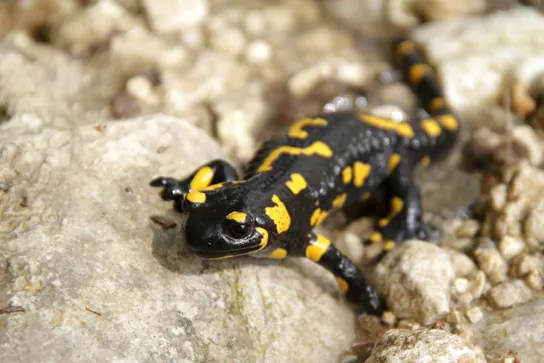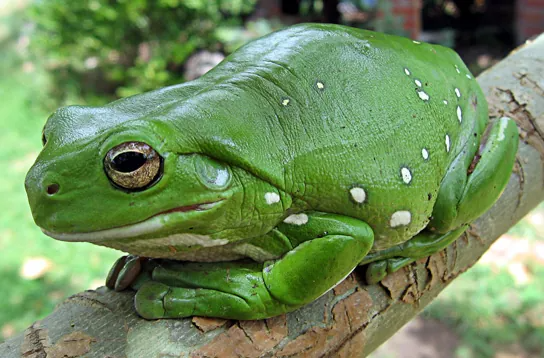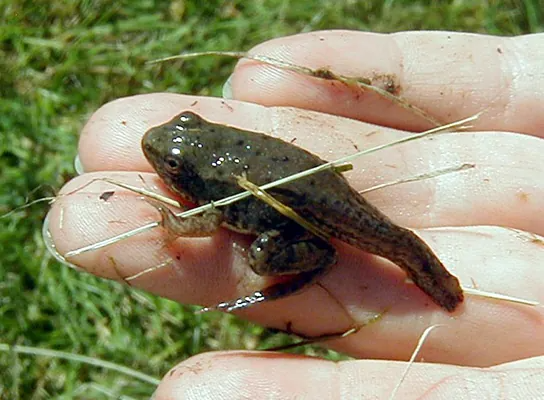29.3 Amphibians
Learning Objectives
- Describe the important difference between the life cycle of amphibians and the life cycles of other vertebrates
- Distinguish between the characteristics of Urodela, Anura, and Apoda
Amphibians are vertebrate tetrapods (“four limbs”), and include frogs, salamanders, and caecilians. The term “amphibian” loosely translates from the Greek as “dual life,” which is a reference to the metamorphosis that many frogs and salamanders undergo and the unique mix of aquatic and terrestrial phases that are required in their life cycle. In fact, they cannot stray far from water because their reproduction is intimately tied to aqueous environments. Amphibians evolved during the Devonian period and were the earliest terrestrial tetrapods. They represent an evolutionary transition from water to land that occurred over many millions of years. Thus, the Amphibia are the only living true vertebrates that have made a transition from water to land in both their ontogeny (life development) and phylogeny (evolution). They have not changed much in morphology over the past 350 million years!
Characteristics of Amphibians
As tetrapods, most amphibians are characterized by four well-developed limbs. In some species of salamanders, hindlimbs are reduced or absent, but all caecilians are (secondarily) limbless. An important characteristic of extant amphibians is a moist, permeable skin that is achieved via mucus glands. Most water is taken in across the skin rather than by drinking. The skin is also one of three respiratory surfaces used by amphibians. The other two are the lungs and the buccal (mouth) cavity.
All extant adult amphibians are carnivorous. Amphibians have image-forming eyes and color vision. Ears are best developed in frogs and toads, which vocalize to communicate.
Amphibia comprises an estimated 6,770 extant species that inhabit tropical and temperate regions around the world. All living species are classified in the subclass Lissamphibia (“smooth-amphibian”), which is divided into three clades: Urodela (“tailed”), the salamanders; Anura (“tail-less”), the frogs; and Apoda (“legless ones”), the caecilians.
Urodela: Salamanders
Salamanders are amphibians that belong to the order Urodela (or Caudata). These animals are probably the most similar to ancestral amphibians. Living salamanders (Figure 29.18) include approximately 620 species, some of which are aquatic, others terrestrial, and some that live on land only as adults. Most adult salamanders have a generalized tetrapod body plan with four limbs and a tail. The placement of their legs makes it difficult to lift their bodies off the ground and they move by bending their bodies from side to side, called lateral undulation, in a fish-like manner while “walking” their arms and legs fore-and-aft. It is thought that their gait is similar to that used by early tetrapods. The majority of salamanders are lungless, and respiration occurs through the skin or through external gills in aquatic species.

Link to Learning
View River Monsters: Fish With Arms and Hands? to see a video about an unusually large salamander species.
Anura: Frogs
Frogs (Figure 29.19) are amphibians that belong to the order Anura or Salientia (“jumpers”). Anurans are among the most diverse groups of vertebrates, with approximately 5,965 species that occur on all of the continents except Antarctica. Anurans, ranging from the minute New Guinea frog at 7 mm to the huge goliath frog at 32 cm from tropical Africa, have a body plan that is more specialized for movement. Adult frogs use their hind limbs and their arrow-like endoskeleton to jump accurately to capture prey on land. Tree frogs have hands adapted for grasping branches as they climb. In tropical areas, “flying frogs” can glide from perch to perch on the extended webs of their feet. Frogs have a number of modifications that allow them to avoid predators, including skin that acts as camouflage. Many species of frogs and salamanders also release defensive chemicals that are poisonous to predators from glands in the skin. Frogs with more toxic skins have bright warning (aposematic) coloration.

The life cycle of most frogs, as other amphibians, consists of two distinct stages: the larval stage followed by metamorphosis to an adult stage. The larval stage of a frog, the tadpole, is often a filter-feeding herbivore. Tadpoles usually have gills, a lateral line system, longfinned tails, and lack limbs. At the end of the tadpole stage, frogs undergo metamorphosis into the adult form (Figure 29.20). During this stage, the gills, tail, and lateral line system disappear, and four limbs develop. The jaws become larger and are suited for carnivorous feeding, and the digestive system transforms into the typical short gut of a predator. An eardrum and air-breathing lungs also develop. These changes during metamorphosis allow the larvae to move onto land in the adult stage.

Apoda: Caecilians
An estimated 185 species comprise the caecilians, a group of amphibians that belong to the order Apoda. They have no limbs, although they evolved from a legged vertebrate ancestor. The complete lack of limbs makes them resemble earthworms. This resemblance is enhanced by folds of skin that look like the segments of an earthworm. However, unlike earthworms, they have teeth in both jaws, and feed on a variety of small organisms found in soil, including earthworms!

